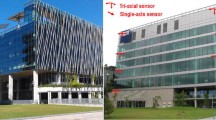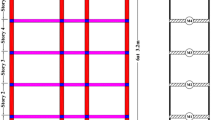Abstract
The IASC-ASCE Structural Health Monitoring Task Group developed a series of benchmark problems, and participants of the benchmark study were charged with using a 12-degree-of-freedom (DOF) shear building as their identification model. The present article addresses improperness, including the parameter and modeling errors, of using this particular model for the intended purpose of damage detection, while the measurements of damaged structures are synthesized from a full-order finite-element model. In addressing parameter errors, a model calibration procedure is utilized to tune the mass and stiffness matrices of the baseline identification model, and a 12-DOF shear building model that preserves the first three modes of the full-order model is obtained. Sequentially, this calibrated model is employed as the baseline model while performing the damage detection under various damage scenarios. Numerical results indicate that the 12-DOF shear building model is an over-simplified identification model, through which only idealized damage situations for the benchmark structure can be detected. It is suggested that a more sophisticated 3-dimensional frame structure model should be adopted as the identification model, if one intends to detect local member damages correctly.
Similar content being viewed by others
References
Doebling S W, Farrar C R, Prime M B, et al. Damage identification and health monitoring of structural and mechanical systems from changes in their vibration characteristics: A literature review. Report LA-13070-MS, Alamos National Laboratory, Los Alamos, N M, 1996
Doebling S W, Farrar C R, Prime M B. A summary review of vibration-based damage identification methods. Shock Vib Dig, 1998, 30(2): 91–105
Sohn H, Farrar C R, Hemez F M, et al. A review of structural health monitoring literature: 1996–2001. Report LA-13976-MS, Los Alamos National Laboratory, Los Alamos, N M, 2003
Johnson E A, Lam H F, Katafygiotis L S, et al. Phase I IASC-ASCE structural health monitoring benchmark problem using simulated data. J Eng Mech, 2004, 130(1): 3–15
Lam H F, Katafygiotis L S, Mickleborough N C. Application of a statistical model updating approach on phase I of the IASC-ASCE structural health monitoring benchmark study. J Eng Mech, 2004, 130(1): 33–48
Caicedo J M, Dyke S J, Johnson E A. Natural excitation technique and eigensystem realization algorithm for phase iof the IASC-ASCE benchmark problem: Simulated data. J Eng Mech, 2004, 130(1): 49–60
Hera A, Hou Z K. Application of wavelet approach for ASCE structural health monitoring benchmark studies. J Eng Mech, 2004, 130(1): 96–104
Barroso L R, Rodriguez R. Damage detection utilizing the damage index method to a benchmark structure. J Eng Mech, 2004, 130(2): 142–151
Ewins D J. Modal Testing: Theory, Practice and Application. 2nd ed. Beijing: Research Studies Press, 2000
Li H J, Zhang M, Hu S-L J. Refinement of reduced-models for dynamic systems. Prog Nat Sci, 2008, 18(8): 993–997
Hu S-L J, Li H J, Wang S Q. Cross-model cross-mode method for model updating. Mech Syst Signal Process, 2007, 21(4): 1690–1703
Hu S-L J, Li H J. Simultaneous mass, damping and stiffness updating for dynamic systems. AIAA J, 2007, 45(10): 2529–2537
Dyke S J, Bernal D, Beck J L, et al. An experimental benchmark problem in structural health monitoring. In: Processing 3rd International Workshop on Structural Health Monitoring. Boca Raton: CRC Press, 2001. 488–497
Author information
Authors and Affiliations
Corresponding author
Additional information
Supported by the National Hi-Tech Research and Development Program of China (“863” Project) (Grant No. 2006AA09Z331) and the National Science Fund for Distinguished Young Scholars (Grant No. 50325927)
Rights and permissions
About this article
Cite this article
Li, H., Zhang, M., Wang, J. et al. Fundamental modeling issues on benchmark structure for structural health monitoring. Sci. China Ser. E-Technol. Sci. 52, 1999–2008 (2009). https://doi.org/10.1007/s11431-009-0115-3
Received:
Accepted:
Published:
Issue Date:
DOI: https://doi.org/10.1007/s11431-009-0115-3




